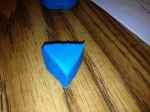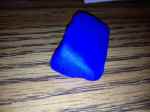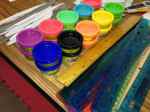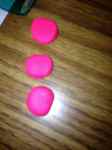When my students are excited about what they are doing in class, they are engaged. They will listen and best of all, learn. The kids were ecstatic when they saw the Play-doh. They couldn’t wait to get their hands on it! The benefits for learning were amazing. All I had to say was “Remember the Play-doh?” and they knew what to do for any volume problem.
Supplies per student:
- One fun-sized Play-doh
- Ruler
- Plastic knife
- Ruler
Instructions:
Many of my students had heard somewhere along the way that volume equaled length times width times height. So, I started by having them make a rectangular prism out of their Play-Doh.
Once it was made, I had them draw a picture of it in their Geometry Booklets. Then they measured and recorded the length, width, and height of their prism in centimeters. Next, I had them cut their prism into 1 centimeter lengths. They observed that the cross sections were squares. I had them find the area of this square. We talked about how many slices they had. So if their area was 6 centimeters squared and they had four slices how could they find the volume of the box? They quickly deduced that they needed to multiply the 6 by 4 to arrive at 24 cm cubed.
I repeated this for a cylinder and a triangular prism. We observed what the cross sections were, found the areas of our cross sections, and then found the volume. To sum it all up, we talked about how volume of a prism or cylinder is the area of the base (cross-section) times the height (number of slices).
It was so much fun!











My students love when we have Play-Doh days! In addition to volume, we use the Fun Factory to model functions (as an input/output model). We didn’t do volume in 8th grade this year, but I have extended this to spheres as well — and they measure volume by smooshing a sphere (technical term) into a cylinder with the same radius. This ends up being 2/3 of the height of the sphere, and they can then discover the formula used for volume of a sphere as well. It’s more of a high school-level activity, but not beyond the grasp of middle schoolers.
Thanks for sharing your Play-Doh fun 🙂
I love the sphere idea! I just taught volume of spheres last week, and that sounds so much more memorable and engaging than the video I showed.
This is also a perfect set up for the understanding of volumes in calculus. Great activity!
Pingback: Creating Tin Men to Explore Surface Area Project | I Speak Math
Pingback: Math Teachers at Play 52 « Let's Play Math!
Reblogged this on hsimmons32 and commented:
I really want to try this for a volume lesson this year.
Hey Michael! Great to hear from you on my blog. I’m so glad that you liked the volume activity! Please let me a if you have any questions at all. The kids LOVED this one!
Even more fun, have students make their own playdough. Using fractions (1 cp. baking soda, 3/4 cup water, 1/2 cup corn starch) – have them double the recipe=multiplying fractions, have them half the recipe=dividing fractions. My kids loved it!
Oh!! That’s sounds so fun! Thanks! 🙂
For volume: I have some volume shapes that can be filled w/ liquid. As an intro./hook to volume I plan to have them fill the shape with water (I have eyedroppers and funnels to make it easier), then pour the water out into a measuring cup. This will give them a picture/understanding of volume (the amount of liquid needed to fill something). Later we will use the same shapes and the formula for volume (cylinder=3.14xr^2xh). “How did your very basic measurement compare with the findings when the formula was used”?
Pingback: Slicing 3D Figures | thenumbertwentyone
I will be using this activity in the next week or so! THANKS! Volume has become a more heavily focused areas for 5th grade CC!
Pingback: Volume of Cones Discovery Lesson | I Speak Math
Pingback: Geometry Class | Ms Moore Math
Pingback: My All Time Favorite Middle School Math Lessons | I Speak Math
Pingback: Volume of 3D Shapes with Play-Doh and Water – Designated Deriver